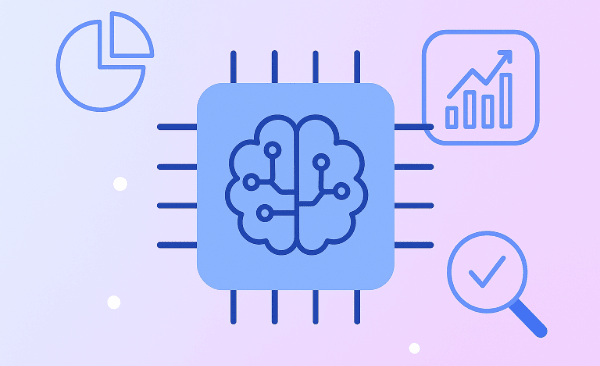Market Research Automation: 2025 State of Play
Automation is reshaping market research in 2025. In a recent Displayr study, 85% of researchers said automated tools have already improved their workflow, namely by helping them save time and enabling faster insights.
But how exactly are the top researchers leveraging automation? Who are the major players? What's next? And most importantly, how can you implement an automation-led strategy effectively to start realizing the benefits? This is your comprehensive guide to automation in market research, designed to help you succeed in this ever-changing field.
The Evolution of Research Automation
When people talk about automation in market research, it can sound like a brand-new concept. In reality, researchers have been automating parts of the workflow for decades. Long before the rise of generative AI, research teams used tools to streamline repetitive processes such as data cleaning, weighting, and crosstabs. Dashboarding platforms helped automate reporting, while scripting languages and macros reduced manual labor in survey design and analysis.
Over time, statistical packages and machine learning methods extended these efficiencies. Automated segmentation, churn modeling, and predictive analytics became commonplace, helping researchers uncover patterns in large datasets without starting from scratch each time. Natural language processing (NLP) also enabled automatic or semi-automatic coding of open-ended responses, reducing the burden of manual verbatim analysis.
Each of these innovations chipped away at repetitive work, creating space for researchers to focus on interpretation and strategy. Today’s advances in research automation build on that foundation, combining faster data preparation, smarter analysis, and real-time reporting into seamless workflows that make projects quicker, more accurate, and more scalable.
How Automation Improves the Research Workflow
Market research is often described as a five-step process: defining objectives, creating a plan, collecting data, analyzing results, and reporting. With this in mind, it's safe to say every stage of the market research process is now being automated to some extent. This means researchers can move faster, reduce errors, and focus more on interpretation than manual work.
- Define objectives: Automated tools can scan customer feedback, social media, and past survey results to highlight emerging trends and recurring issues. This gives researchers a faster way to identify key questions and sharpen their research objectives without manually trawling through data.
- Create a plan: Survey platforms and research tools increasingly automate parts of study design—suggesting sample structures, balancing quotas, and even handling logic or routing automatically. Instead of manually setting up every parameter, researchers can lean on automation to build more efficient and consistent plans.
- Data collection: Automation streamlines the nuts and bolts of data gathering. Sample management, reminders, and real-time validation checks can now run automatically, ensuring higher-quality responses with less manual oversight. Fraud detection systems also flag suspicious entries before they corrupt results, reducing data-cleaning headaches later.
- Data analysis: This is where automation saves the most time. Coding open-ended responses, generating crosstabs, running statistical tests, and applying weights are all tasks that can be automated. Instead of spending hours on manual work, analysts can focus on interpreting the results and drawing meaningful insights.
- Reporting: Report automation closes the loop. Dashboards update in real-time as new data is received, and presentation software can be linked to data sources, allowing charts and tables to refresh automatically. Rather than rebuilding slides each wave, researchers can concentrate on telling the story behind the numbers.
Together, these automated steps are transforming how projects are delivered. What once took weeks of manual labor can now be achieved in days—or even hours—freeing researchers to focus on the strategic questions that really matter.
Automated Survey Deployment
As mentioned above, the data collection process is already being heavily automated with the rise of new tools. Instead of manually setting up every step, researchers can now use platforms that streamline the process end-to-end. This might involve:
- Survey setup: Automated tools can handle skip logic, routing, and quota management in the background, reducing the risk of human error.
- Sampling and reminders: Contact lists can be managed automatically, with invitations and follow-up reminders scheduled without manual intervention.
- Quality checks: Built-in validation rules and fraud detection algorithms flag suspicious or low-quality responses before they compromise results. This helps protect data integrity at the point of collection, reducing the need for extensive cleaning later.
Together, these capabilities allow researchers to launch surveys more quickly, collect cleaner data, and focus less on administrative tasks and more on the insights that matter.
Automating Data Preparation
Data preparation is one of the most time-consuming parts of any research project. Cleaning raw files, fixing errors, and organizing variables can take hours before the real analysis even begins. Automation now removes much of that manual effort, ensuring datasets are analysis-ready from the start. Some innovations around automating the data preparation process include:
- Data cleaning: Automated checks can flag incomplete responses, detect duplicates, and identify outliers before they skew results.
- Variable management: Tools can automatically relabel variables, restructure data into consistent formats, and apply predefined coding schemes without human intervention.
- Weighting and balancing: Instead of manually calculating weights or adjusting quotas, automation can instantly apply rules that ensure samples match population benchmarks.
- Merging and transformation: Multiple data sources can be combined automatically, with platforms aligning IDs, formats, and structures in the background.
These steps reduce human error and save researchers countless hours of repetitive work. More importantly, they create a consistent, reliable foundation for analysis—so when insights are generated, stakeholders can trust the results.
Want to learn more about data cleaning? Check out our market researcher's guide to data cleaning tools.
Examples of Research Automation in Practice
The adoption of automation in research isn’t limited to one part of the workflow or one specific tool. Rather, it’s happening across survey design, analysis, and reporting. A few examples include:
- Survey platforms now automate tasks such as sample balancing, reminders, and real-time quality checks, helping researchers collect cleaner data with reduced manual oversight. Some examples include Survio, Alchemer, and Pollfish.
- Analysis platforms, such as Displayr, embed automation into everyday workflows. For example, researchers can automatically weight data, generate crosstabs, or code open-ended responses at scale. Reports and dashboards update live as new data is added, eliminating repetitive setup work. Some other examples include Sogolytics, Statwing, and Crunch.io.
- Reporting solutions integrate directly with survey data, automatically refreshing charts, tables, and slides so insights are always up to date. Some examples include PowerBI automation flows, Zoho Analytics, and ChartExpo.
A Step-by-Step Guide to Automating Research
Automation now supports every stage of the research process, and it's something that you can (and should) implement into your workflow today. Although every project is different, and every researcher will take their own unique approach, a basic step-by-step guide to research automation might look like:
- Sharpening the Brief: Background research and knowledge gathering can be automated. Tools can scan previous survey data, customer feedback, and even social media mentions to surface trends and gaps. This helps researchers write sharper briefs and align stakeholders more quickly.
Tools to use here include Talkwalker, Pulsar, and Meltwater. - Building the Framework: Survey and study design is faster with automated quota management, routing, and pre-built templates. Instead of manually setting up every parameter, researchers can use automation to reduce errors and speed up launch.
Tools to use here include Alchemer, Survio, and Typeform Logic. - Smarter Collection: Automation in fieldwork ensures samples are balanced, reminders are scheduled, and quality checks run in real time. Fraud detection systems can flag bots or suspicious responses before they contaminate datasets.
Tools to use here include Pollfish, Cint, and CheckMarket. - Accelerated Analysis: From auto-coding open-ended responses to running crosstabs and significance tests, automation removes much of the grunt work. Analysts can spend less time processing and more time interpreting results.
Tools to use here include Sogolytics, Displayr and Statwing. - Insightful Outputs: Dashboards and reports now update automatically as new data arrives. Charts, tables, and even PowerPoint slides refresh without the need for manual rework, freeing up researchers to focus on telling the story.
Tools to use here include Displayr, Klipfolio, and ChartExpo.
Future of Market Research Automation
Predicting the future is hard. Who would have thought that market research would be so fundamentally transformed by automation five years ago?
That's why it's challenging to make definitive predictions about what the future will look like. What we can do, however, is examine the current trends and make an informed judgment on how these patterns will continue to evolve in the near and distant future.
With that in mind, expect to see greater data integration, with survey, CRM, and social data automatically combined to create richer insights. Real-time reporting will become the norm, as dashboards and slides refresh instantly, rather than waiting for the next update.
In short, automation isn’t just improving research—it’s becoming the backbone of how insights are delivered.
Ready to see the future of automation in market research? Sign up for Displayr to see what's possible. Start free today.

